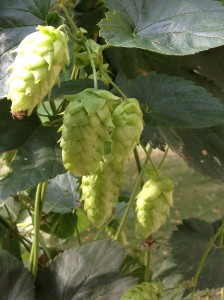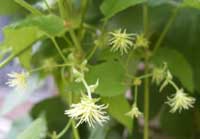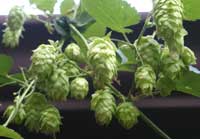Grow Hops
Growing hops
In recent years the popularity of microbreweries and home brewing has been on the increase. Unfortunately, due to a higher demand and rising shortage of hops, the cost of beer production has increased – all the more reasons to grow your own hops. 
Hops is the bittering agent that gives beer its distinctive flavor and a key ingredient in making beer. There are many varieties, each imparts a different aroma and flavor to the beer.


Hops (Humulus Lupulus) is a hardy perennial that is grown from the rhizome of a female hop plant. It can grow vines up to 25 ft in one season which will die back in the winter. It requires 120 frost-free days to produce ripe flowers and given the right conditions will yield 1/2-2 pounds of dried flowers per vine.
Growing hops
Plant the rhizome in full sun and deep in well-drained soil, with a ph of 6-7.5. The top of the rhizome should be 1 inch below the soil surface. If you plant more than one variety, plant them at least 5 ft. apart to avoid mixing of vines, otherwise plant them 3 ft apart. When the vines are 1 ft tall be sure to provide a trellis or support ( twine) to climb on and choose the best 2-3 vines to wind around the support. Leave a few for backup (in case of frost destroys one) and prune away the rest . Once they get started they can grow as much as 12 inches per day. Around the end of June the plant will grow sidearms (flowering stage) which produce the hop cones.
The first year of growth is critical in establishing the root system, so be sure to keep the plants well watered (not soaked) weed free and mulched. A side dressing of a balanced fertilizer or compost tea during the growing season will help produce optimal growth. You may not get many hops the first year but production should increase in subsequent years.
Harvesting hops
Usually, there is little to pick the first year but by the second year, there should be enough to harvest. Typically, they can be picked at the end of August or September before a frost. The cones should be yellowish to a pale green color and feel papery and light. To test if they are ready to pick squeeze a mature hop between your fingers, if it stays compressed, feels soft and damp , then they are not ready. If it springs back and emits a “hoppy”aroma then it is mature enough to pick. Mature cones will have a dark yellow powder known as lupulin which is in the center of the cone. Lupulin contains all the acids and oils that emits the hoppy aroma and can make you “loopy”. It is what flavors the beer.
After harvesting, hops need to be dried or they will spoil. A food dehydrater works nicely. If you don’t have one, place your hops on a screen and dry outdoors away from direct sun or dry them in your oven at a low temperature. Place dried hops in vacumn sealed or ziplock bags squeezing out as much air as possible, then store in a freezer. To test if your hops are dry enough, pull on the petals if they break off easily and the inner stem is brittle enough so that is breaks instead of bends, then your hops are dry enough to store.
Hop rhizomes can be purchased at homebrew supply stores as well as on the internet.
Even if you’re not a brewer, hops make an attractive ornamental vine which can be used to make decorative wreaths.
source: www.uvm.edu/-pass/perry/hopsmore.html http://brewery.org/brewery/library/HopGrow.html
My neighbor has hops she has been growing for 4 years. They are really big and look really good. The other side of my yard has chain link fence and it’s looking right at the side of my neighbors house. I would like to plant hops on that side of the yard as a screen. I was just wondering if I should plant in the spring or in the fall. Also do I put the whole pine cone shaped thing in the ground or should i open them up and just put the seeds in. Thanks for your help and ideas. Steve
Hi, I hope you will get back to me with an answer. I have purchased some Hops rhizomes at a local nursery. I want these vines for a privacy shield in the summer. Can this be accomplished by setting them out on the borders of my yard? I could not find a trellis that would be tall enough for them but I am wondering —– If I take 2 stakes about 8 ft. high and set about 3 feet apart and stretch chicken wire between them —— will the hops grow up the chicken wire??? Also if the Hops grow more than the 8 ft. should I cut off the excess at the top or let it hang down (like a willow branch? Now for my next quewstion — I am also interested in planting the Hops on a bank (hillside sloping downwards) in my backyard as a ground cover for the bank. I keep it free of weeds and it is just soil at present as I keep killing the weeds with Roundup —–. I do not want a ground cover like crown vetch as it grows up the slope and comes into my lawn. I think the hops would be pretty for this purpose. Would they spread underground and fill the slope? The bank is about 12 – 15 ft. high and about 80 ft. wide. If it is appropriate to plant Hops, should I plant them at the bottom of the slope and let them grow up the slope —— or would they grow down the slope if I plant them at the top of the slope?? My yard is at the top of the slop. Please let me know and I would be most appreciative in hearing your answers. I am a first time Hops grower and have been a gardener for many years. Thank you for any information you can give to me. Barb
Will they grow as tall in as short of time in semi shade?
How well will the hops grow in shade though?
hi im just starting….i live in central california, i will not get my plants until march, i was wondering if i should cover the plants it gets hot here, anytime after may?
Cut hop vine
Do I cut vine down in the fall?
i bought my rhizomes from adventures in homebrewing…. so far so good. i just need to keep my neighbors cats from using the wood chips as their personal litter pan! i have 6 kinds planted and may reduce to either just 6 plants and just 2 kind or even just to one kind.
WHERE CAN I FIND FREE RHIZOME TO GROW MY OWN HOPS. HOW MANY DO YOU RECOMMEND (PLANTS TO START MY FIRST CROP)
THANK JOHN
need to find suppliers of hops vines
Good basic information. If you are looking for much more detailed information specifically about growing hops for making beer, our ‘Grow-Hops’ group has 1,894 members, a rhizome exchange, a whole-hop exchange, a HopWiki project, and lots more. If interested, contact me — billvelek AT alltel DOT net (remove munge).
Cheers.
Bill Velek